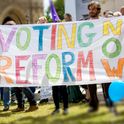It’s general election week, and that means two things for party activists. One, every single one of them is now sleep-deprived, running solely off Wetherspoon's coffee and constituency office biscuits. Two, they’re nervously eyeing Thursday’s weather forecast.
It’s a long-held belief that bad weather is risky for Labour’s turnout in particular. Anthony Howard once called a rainy evening “a frightening prospect” for the party, reflecting the theory that working-class voters who head to the polls after tea would be less likely to venture back out in grim weather.
Fast-forward to 2019, and with some parts of the country forecast snow for polling day, worried activists are now anxiously refreshing their weather apps, hoping that the chill won’t put off voters.
But are they right to do so? Stephen Fisher, a politics researcher at Oxford University, analysed 15 years of elections up to 2002 and found there was no obvious correlation between turnout and the weather. (There is a caveat to this: if severe transport issues come into play—and there are reports of disruptions Thursday—or polling stations close, people could struggle to get to the polls.)
Shorter days, too, seem not to have much impact, with the University of Strathclyde’s John Curtice recently citing the two post-war February elections—both of which had high turnout—as evidence that a bit of gloom won’t stop voters exercising their democratic rights.
There is, however, another caveat to the above: and it’s related to something that does affect whether or not someone is likely to get out and go to the polls.
Although the weather doesn’t have an impact, Fisher suggests, there is a variable that measurably does: “Having been contacted by a party worker makes a difference to turnout,” he says.
Conventional wisdom has it that this is particularly important for the Labour party, with activists often citing a strong ground game, fuelled by Momentum volunteers, in helping to narrow the polls in the final weeks of the 2017 general election campaign.
A 2010 study found that the “more people canvassing for a party in a constituency … the better its performance there.” With the Conservatives spending more money but less time on the doors during recent campaigns, Labour, in particular, has focussed efforts along exactly these lines.
Analysis of 2015, for instance, showed a correlation between Labour door-knocking and Labour votes, with the top ten best-performing seats in terms of voter contact showing an average 5.1 per cent increase in Labour’s vote.
Jumpers and clipboards
That works nicely in a spring election—but what about in a December one? “Don’t name me on it,” one well-connected Labour activist said, “but I’m hearing from so many organiser/MP/staffer friends that the weather is putting off activists.”“A lot of the time it’s just ‘core’ groups going out campaigning, i.e. the die-hard CLP [constituency Labour party] members, or the candidate’s staff.”
Another seasoned campaigner, who has been door-knocking in a Labour-majority Northern seat, agrees. “There is nowhere near as many [people out] as previous elections. It’s the same in a lot of places outside of London.” In some seats, they say, contact rates are as low as a third of 2017's.
“The cold and rain really doesn’t help, especially because lots of the volunteers will be older.”
Another campaigner, who has been canvassing across the North West, agrees. “Where I am, it’s been difficult being safe with the cold and activists being older.”
“It’s become noticeable we have to be more defensive; activists are being migrated to seats that have previously struggled.” This tallies with Conservative reports that key marginals are looking encouraging on the ground.
Both activists add, however, that it has started to improve, with an uptick in volunteers over the past week. According to a Momentum spokesperson, last week 30,000 people used their “MyCampaignMap” tool to find a campaigning event to attend, including mass canvassing sessions attended “by thousands of doorknockers.”
The digital election?
There is another cause for Labour hope, too. The same 2010 research that found vote share correlates to ground game also found that a face-to-face conversation wasn’t the only way to influence voters. “Just getting a leaflet increased the percentage [of previous Labour voters] intending to vote Labour again from 48 to 57 per cent,” the researchers found.What’s more, 79 per cent of previous Labour voters who got an e-mail from the party intended to vote for Labour again, compared to 48 per cent of those who didn’t.
Nine years on, in the age of social media campaigning, it may be that digital contact can make up for an ailing ground game. With 2017 analysis suggesting Labour “won the social media election”—and some Momentum Facebook ads posted this weekend receiving over 20,000 impressions in less than 24 hours—it may be that when the weather closes a voter’s door, it opens a browser window.












